Steelhead tactics, brookies, and thoughts on Lake Superior coldwater from guides Ken Petersen and Rob Storrar…
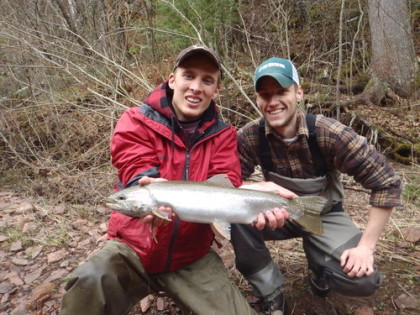
Minnesota’s North Shore is perhaps one of the most overlooked fisheries in the Upper Midwest, though there are boundless opportunities for epic fishing and adventure. While it does get a fair amount of attention for steelhead runs and its rugged trout streams, the Shore is often overshadowed by places like Wisconsin’s Brule River and the Upper Peninsula, not to mention all the walleyes in Minnesota. And that’s kind of a shame.
Ken Petersen and Rob Storrar, the two young, innovative anglers that own and operate North Shore Troutdoors guide service, are on a mission to share what the Shore truly has to offer and to kill the notion that Minnesota’s north country is only the land of walleye and bass. Though relatively new on the North Shore guiding scene, there’s no lack of experience and skill in this crew of anglers. Ken has been fishing for nearly as long as he’s been able to walk and is constantly pushing the limits with innovative steelhead fly tactics on the North Shore (he recently started swinging streamers (and catching fish) on switch rods and fluorescent chartreuse and blue line, much to the bewilderment of local anglers). Most of the thoughts below are his, but Rob adds a few as well. Rob is on the Phenix Rods prostaff (along with a few other companies), fishes bass tournaments throughout the summer, and recently worked the Bassmaster Classic Expo. More importantly, they have a deep passion for the fishery on the Shore and genuinely care about introducing new anglers to the outdoors and sharing innovative fishing techniques. Not to mention they’re just good guys.
I was pumped when they graciously agreed to share some of their favorite strategies and tactics for steelhead and some insights on the epic coldwater fishing in northern Minnesota. There’s certainly no shortage of spirited discussion on the state of the fisheries and the North Shore steelhead scene, and mostly for good reason, but there’s also lots of profound fishing wisdom mixed in. It’s a vibrant interview with great fishing tactics and insights on a wild, fascinating fishery with many undiscovered frontiers and plenty of epic fishing adventure.
1) 3 Brothers Flies (3BF): Before we get into steelhead tactics and the North Shore fisheries, tell us a bit about North Shore Troutdoors…
North Shore Troutdoors: The reason we started North Shore Troutdoors is because we wanted to see a change on the shore. We are always hearing the “old guys” talking about when they fished during the 70’s and 80’s how there were so many fish around you could walk across their backs. Since that time the Lake Superior fisheries have taken a huge hit and have fallen on the back burner of the Minnesota DNR. We aren’t in the guiding business for the money, we are in the guiding business so we can introduce more anglers to the north shore of Lake Superior in hopes that we can gain more support in building these suffering fisheries back up.
As for the fly fishing, to make a long story short it is the closest thing I can get to fighting a blue water fish. I have always liked the ocean and catching fish. It is common sense that those fish pull twice as hard as anything we would see in the Midwest so using a fly rod is as close to the ocean as I can get without being there. I also use a fly rod, or switch rod, because I want a challenge. It is really easy to take a spinning rod and go catch steelhead or trout and I am not about that. Fly fishing is along the same lines as bow hunting. I want to get up close and personal with the fish. For me I am not in a hurry to go and catch fish and leave. I like being outside and observing the fish. I like to see what they are eating and where they are moving. It the best feeling in the world when you can take a fly that you made and trick a fish over 20 inches into eating it.
2) 3BF: Steelhead Alley and Michigan’s UP tribs seem to get lots of attention when guys start talking about steelhead in this corner of the Midwest. Why fish Minnesota’s North Shore and what makes it so special?
North Shore Troutdoors: Minnesota is neglected in the Great Lakes Steelhead scene because of the runs. Our runs do not last as long as the runs in Michigan and the Erie Tribs. We also do not have the variety of fish coming through like you see out east of us. At one time we did have the same runs, and during that time Minnesota’s North Shore was just as big as the UP. The runs would start in the spring and different fish would be found entering the rivers almost all the way until winter. Since that time the fishery has been neglected to Steelhead in the spring and Pink Salmon, along with a few coastal brook trout and cohos, in the fall. The reasoning behind this is because Lake Superior is said to be at its capacity. The lake trout, one of the two native game fish in the lake, have rebounded and their population has recovered to above normal levels. With this a lot of the stocking of exotic species, salmon and steelhead, have been removed from the north shore. The French River Hatchery does stock Kamloops throughout the summer to keep the “meat hunters” happy but it does not do a lot of good for the fishery as a whole. (Editor’s note – The MN DNR also shares some info on the “band-aid” approach, stream conservation, and the anadromous rainbow population on the “Hatchery Fact Sheet – Duluth Area” under the “North Shore Steelhead and Kamloops Management” section. It can be found here)
The North Shore Fisheries also suffer with stocking because of the lack of funding. There are so many people in the state of Minnesota that are walleye hounds so that is where you see most of the money going. It is incredible to see how bad the Michigan stream stocking programs surpass the north shore. We have one hatchery on the shore that tries to raise cold-water fish but it is falling apart, and it is up in the air on what is going to happen with the stocking. Recently part of our cold-water hatchery was used to raise sucker minnows for muskie rearing ponds which was later suspended, we were told, because of the VHS outbreaks in the Great Lakes. It is insane to think that our fishery’s only life line was being used for muskie bait instead of it’s intended purpose. (Editor’s note – The “Hatchery Fact Sheet – Duluth Area” page from the MN DNR notes this sucker minnow discontinuation under the “History” section. It can be found here)

The reason Minnesota’s north shore should be considered with the other greats is because if the access. We have around 60 Tributaries from Duluth to Canada that hold fish in the spring and fall, and for the most part they are all accessible. There is not a lot of private property along the north shore which makes fishing for anadromous fish fairly easy. A lot of our rivers are also a bit narrow and are not really navigable by boat. Anglers are able to walk into almost every section of the rivers on foot which is also another huge plus for the north shore rivers. To top it off, if one river is not producing fish anglers are able to hop in their car and take a five minute drive to the next river. It is truly a unique area to fish for lake run fish.
3) 3BF: Favorite North Shore fish to target with a fly rod?
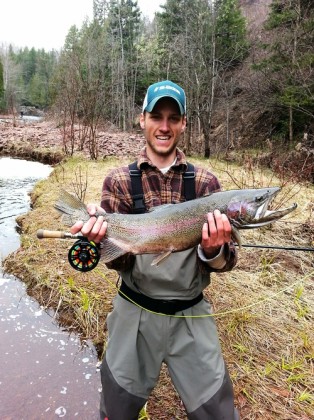
North Shore Troutdoors: Steelhead is the obvious choice. Fishing for this species of fish is like big game hunting. If you want to be successful in catching these fish you cannot just grab a rod and reel and head into the water. We do a lot of research throughout the winter learning different fly patterns and techniques to try and get the upper hand come spring. There have been a lot of times where we can see the fish and they will not take anything we are throwing at them. This fishery takes practice and a lot of trial and error in order to be successful and that is why I think that steelhead are the best fish to target on the fly.
4) 3BF: N. Shore streams are quite rugged and often have a pretty good gradient. Are there any notable presentation strategies you use on the Shore that differ from Lake Michigan tribs or other classic steelheading venues?
North Shore Troutdoors: I think this is one of the most important questions in the interview. Yes, our streams are rugged and there are a few that are down-right dangerous, but in the end we are all fishing for the same type of fish. Steelhead alley and other Michigan tributaries hold bigger fish because of the difference in water temps and genes, but in Minnesota we still have plenty of fish at or over thirty inches. Part of North Shore Troutdoors is learning about the steelhead in other great lakes and on the west coast during the winter. We have developed new fishing styles and have learned different techniques in order to prove that these fish will react the same as they do everywhere else in the United States and Canada.
When we first started fishing on the north shore we found that there were a few older anglers using a “different” technique. We call it the “Lester Twitch”, it is similar to the Kenai Twitch except for equipment. In order to participate in the Lester Twitch an angler needs to get a fly rod and reel, take all the fly line off of it, and replace the line with Maxima Chameleon. You then need to overweight your line with heavy split shot and an egg fly. Once you are all rigged up you lob your rig up stream and bounce it through a run making sure your bounces are abrupt. At the end of the swing you want to give your egg one more good yank just in case there are any steelhead mouths near your hook. If you don’t end up snagging, excusing me, “CATCHING” one the first time just keep lobbing it….
Hopefully you have caught onto the sarcasm. We would never use this method of steelhead fishing on the north shore, and we are trying to show people different ways to catch these fish so eventually this style of fishing dies out with the generation. This style of something, I can’t call it fishing, was developed years ago for meat hunting. It is an effective way to hook a fish by the mouth or face so it can be taken home to eat. This technique out west is referred to as “flossing” and is used to hook fish who are struggling with a case of lock-jaw. Since steelhead do not have a case of lock jaw, and we haven’t kept steelhead on the north shore for quite some time, there is really no need to use this style any longer. We have seen way too many fish banged up in the process and it is not worth it. There are PLENTY of new, very productive methods that can be found on the internet where an old style of fishing like this should be on its way out. We are very fortunate to have social media and a wealth of knowledge at our finger tips and so we should be using these resources to help learn and protect our fishery.
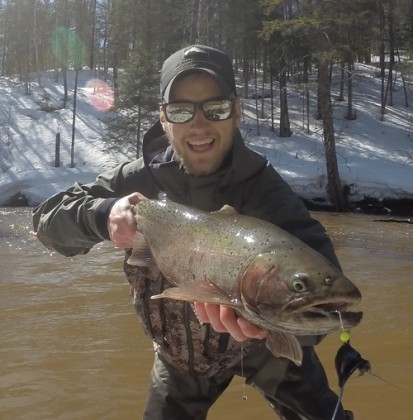
As for our presentations, it’s a simple, complicated system. If we are fishing on our own we do not care about the number of fish we catch; we only care about how we catch them. During the winter we research and tie up different patterns to test once the rivers thaw. For me personally, I do not care about how many fish I catch, I want to outsmart them. The only fly I do not use on the shore are egg flies because there are better techniques at catching these fish, and there are more and more studies coming out that say that these types of flies do more harm than good to the fish. When the fish are in the rivers and they are eating eggs they destroy them. When an angler throws an egg pattern through a run on a fly line they inhale them which makes it harder to remove the fly once the fish is landed, which usually does more harm than good to the fish. We focus on quick landing, photo, and releases. We also do not use egg flies because that is what the majority of anglers use on the rest of the shore. These fish are not stupid. We have found that if we change up the presentation we are more successful on catching fish. Plus, if we went out and only used an egg fly every time we fished we would not learn anything different.
I started experimenting with different styles of fishing on the north shore because I was told I couldn’t do it. When I first moved here I had bright yellow supra fly line from SA and I was told that there was no way on earth I could catch a steelhead on fly line, let alone bright yellow. That fish was checked off the list that same morning. I was then told I couldn’t use a switch rod in our rivers because it was too big so I sold my 8 wt and only fished with a switch rod.
My latest encounter with a steelhead was this spring on the Brule (north shore was still frozen) on the switch fishing a style I was told I couldn’t do. I was swinging a fly on a Senyo shank with Royal Wulff Ambush Line (line is florescent chartreuse and blue). I was told that “our steelhead” do not react the same way as their cousins in the great lakes and out west, and, that they would never eat a fly swung through a run on chartreuse line. The angler was wrong and I believe the photo is still on greatlakesflyshop.com if you’re curious. (Editor’s note: see pic above). For us it is all about the challenge and progression. Rob and I compete with one another while we are fishing together because we want to get better. We take criticism on certain styles of fishing as a challenge. We want to see how far we can push our fishing capabilities so we can better understand how these fish respond during different times of the year.
It’s a lot of rambling in this question but to make a long story short if you can present a well placed fly through a run on the north shore you will have success just like anywhere else in the world. Every time we start to put our gear on it is like getting ready to go hunting, and I think any guide will tell you that. Before you can start to fish you need to be able to observe, and if you cannot observe your fishing will lack.
5) 3BF: What are absolute perfect water conditions for steelhead?

North Shore Troutdoors: If its spring time and the rivers are running there will be steelhead. Our favorite times are when the rivers have a bit of color but we can still see the fish moving around. The first major drop in water speed and rise in temperature generally signals a major push of steelhead in the spring so we anxiously await the days leading up to this initial drop. Once ample amounts of fish have made it into the river, the water will tend to fluctuate based on run-off and spring rains. Even in high, fast waters, fish will still be in the river, but they will be much harder to catch and to present a bait to. Because of this we prefer falling water speeds that are coupled with slightly rising water temperatures and some coloration to the water. The only reason we prefer the color is because fish will be less spooky and generally won’t get as good of a look at your presentation so therefore will not be as fussy. If we had to pick an ideal day for steelhead fishing we would hope for a warm night that broke into an overcast, but humid day featuring water that had just stabilized after its initial rapid fall following ice out.
We also like it in the fall when the rivers are clear because it doesn’t get much better than sight fishing for big fish. At this time period the fish tend to be more aggressive due to the warmer temperatures, and flows tend not to matter as much because we are not coming off of the winter thaw.
6) 3BF: What steelhead setup are you guys fishing on a daily basis?
Ken: I use a switch rod during the spring and fall fisheries. It’s a 11’ 3” two handed fly rod that I can use for a few different types of fishing situations. If I am going to swing a fly through a run I will use a running line, Skagit head, versi leader (sink tip), and type of streamer. I can also switch the line to a switch line which allows me to run an indicator with flies underneath.
Rob: For me I will use a combination of tactics depending on the day. My favorite way to fish is with a medium heavy bait caster made by Phenix Rods. On this setup I spool 30 pound braid onto a high speed Lews bait casting reel, and attach a 10 pound fluorocarbon leader on a barrel swivel. From there I put a clear center pinning float on the line followed by staggered weights. At the end is our homemade pink worm or plastic spawn imitation. The rod I used last year was a 7’2” M1 Phenix that had ample back bone but a very sensitive tip that allowed for accurate casts yet didn’t pull hooks out of a fishes’ mouths. This fall and next spring I may be experimenting with an even longer Phenix Rod as well to get a better high sticking presentation.
If I’m not fishing the bait caster I will be experimenting with an 8wt fly rod, and presenting a bead or a nymph below an indicator. Also, in order to stay fresh on all tactics, I will bring a Phenix spinning rod and fish it when the conditions are right or when we have clients coming up that will not be fly fishing.
7) 3BF: What’s the biggest/most common mistake you see anglers make when targeting steelhead?
North Shore Troutdoors: There are three “mistakes” we see new anglers making on the north shore, the first being a lack of knowledge. What I mean by this is that anglers new to the area are not reading the regulations and do not know exactly what type of fish they are catching. Because of this, new anglers are handling the wrong species of fish incorrectly, and in turn, it is hurting the fishery.
Another mistake new anglers seem to make when targeting steelhead is crowding other anglers. Growing up in Minnesota I would venture to say that the majority of people grew up fishing lakes or ponds. Docks, boats, and shoreline have always been easily accessible and so that is how most of us cut our teeth with the rods and reels. When an angler switches to river fishing for the first time it is like a deer in the head lights. The water is constantly moving and switching directions, and it is hard to tell where a fish could be holding. We see quite a few anglers that just wait to see a fish landed then run right up next to the person and start fishing instead of reading, watching videos, and observing other anglers’ techniques to learn the best ways to catch fish. It is understandable because in steelhead fishing there are very few teachers on the water. In Minnesota we all grew up with teachers whether it be our grandparents, our parents, or our siblings teaching us different techniques at catching warm water species. Never the less it is quite annoying when an angler runs up next to you when you are battling a fish. All it does is screw up the fishing for both people because usually these “runners” take the shortest path to the nearest angler, which is usually right down the center of a run.
The last major mistake we see anglers make on the North Shore is not keeping an open mind when it comes to their angling techniques. Steelhead, stream trout, and salmon are just like any other fish; what worked today may not work tomorrow, and vice versa. Especially during the steelhead season we see so many anglers relying on one technique and closing their mind to other techniques that may be more productive at that particular time. For example there are times that steelhead are on the bottom, suspended, or even riding high in the rivers, and that same old technique that is being used may not be the best presentation at the time being. We experiment day in and day out to learn what the fish prefer on that certain day or during that time span in order to capitalize on fish behavior and preferences. Bringing an open mind to the rivers can really help anglers capitalize when the fishing seems to be tough.
8) 3BF: It seems like steelhead and trout above the barriers get lots of (well-deserved) glory, but they can’t be the only worthy pursuits in the Lake Superior system. What’s the most overlooked fish(ery) on the shore?
North Shore Troutdoors: The most overlooked fishery on the north shore is pink salmon. Most anglers overlook this fall fishery because the fish are small and a lot of guys do not like the taste of them. We call pink salmon “steelhead training wheels” because it is the best way to learn how to target steelhead. When the pinks are in, the water is clear, and they are everywhere! For the most part you can target the pinks by sight fishing. Anglers are able to walk right up to the fish and see their fly as it floats past. They are able to see how the fish react to the fly based on how it is presented. The fish will let an angler know if the fly is coming too slow or if there is something about it they don’t like. An angler can then take the techniques they have learned while fishing for pinks and apply them to steelhead in the spring. This greatly increases the chances of success while fishing for steelhead. Fishing rivers is all about learning. A river is always changing and the fish are always moving. If you aren’t learning every time you are out in the water you cannot increase your fish-catching-productivity rate.
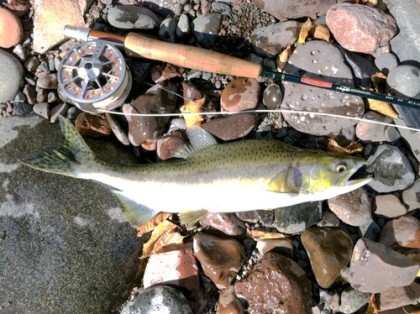
9) 3BF: The brookies up there and the rugged, mountainous creeks have always intrigued me. What’s up with the brook trout fishery and what are your favorite strategies?
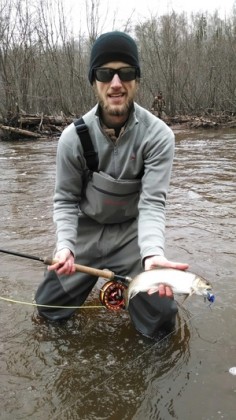
North Shore Troutdoors: The brook trout are everywhere up here but there are certain areas where the big ones hang out. They usually are the smaller of the species of trout found on the north shore but we have battled with a few pushing 20” (native stream trout, not coasters). The best way to find good brook trout is to start walking. Our rule up here is the rule of One. This rule states that the majority of anglers/tourists on the north shore only walk one mile into the river, and because of this, those areas get fished the hardest (this isn’t a written rule we just made it up). If you take the time to look at satellite photos and plan a route into the woods before-hand it is a lot easier to find the bigger fish. Our rivers are rugged but there are also deep pools scattered throughout all the way to their headwaters. The best time to catch these brook trout is in the fall when they are feeding and getting ready to spawn. During this time they are at their most photogenic state with their spawning coloration. The brook trout fisheries are a very over looked fishery on the north shore, and we are really working on bringing more people out into our northern scenic rivers to catch these beautiful fish.
As far as tactics go for these fish, nothing really beats a dry fly when the fish are really putting on the feedbag. When the fishing is more difficult, standard nymphs work great. Generally when it comes to brook trout here, the first step is finding the right area that is holding many good sized fish. Then from there it is a matter of matching the hatch and experimenting until you find out what is working best for the day.
10) 3BF: Top 3 steelhead presentations?
Stones, Intruders, and beads. And we can’t forget the all powerful pink worm!
3BF: Where can people learn more about your guiding or set up a day of fishing on the Shore?
We can be contacted at www.northshoretroutdoors.com for booking information and fishing reports. We are also on Facebook, Instagram, and Twitter which we update daily so you can always see what we are doing.

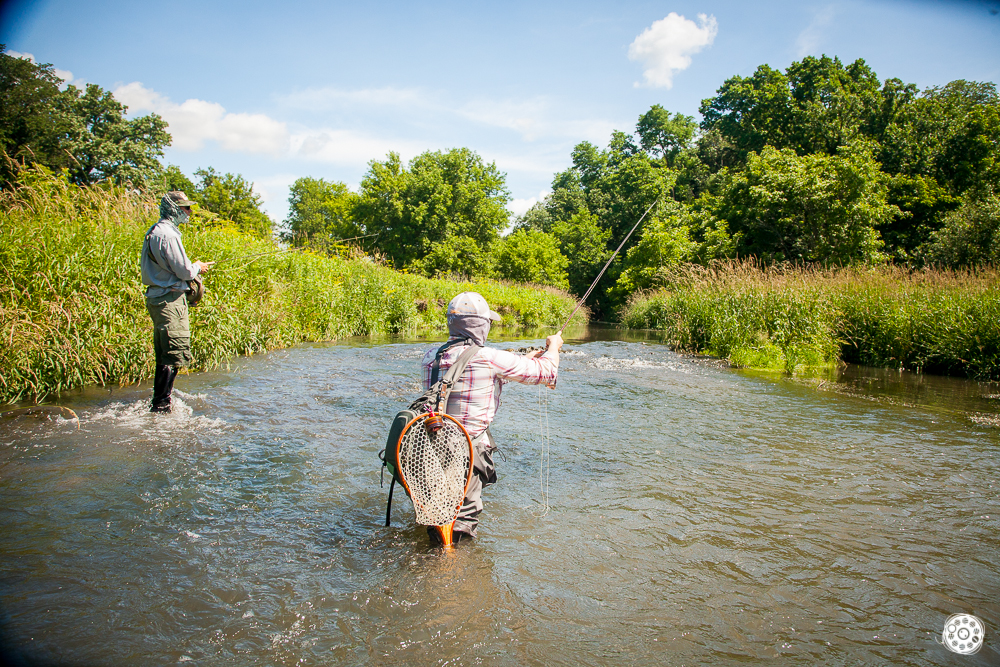
Love the site and passion. Taking my 11 yr old up from Mpls 9/5. He is hoping to repeat the slam on pinks from 3yrs ago. I tell him if there not in we’ll look for brookies and have fun, but there is not many posts on the web. If you have any insight or spots to camp close to fishing action for pinks or brooks that would be appreciated. I have wife and daughter along so I am not as mobile and hoping to find a place close to a trout spot, that is all my son wants to catch, size does not matter but a big brook would be sweet. By the way I have hoards of pheasant feathers, and some nice caribou hide I would be willing to trade for a little info.
Peter – just sent an email. I’m not very familiar with the area so unfortunately I can’t offer any good spots :(